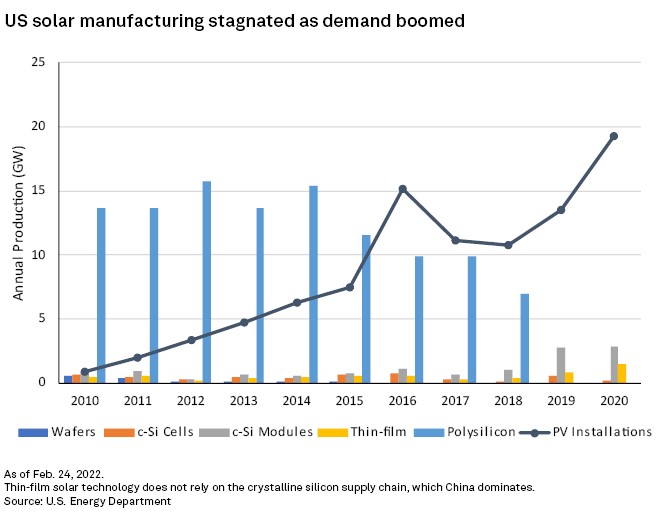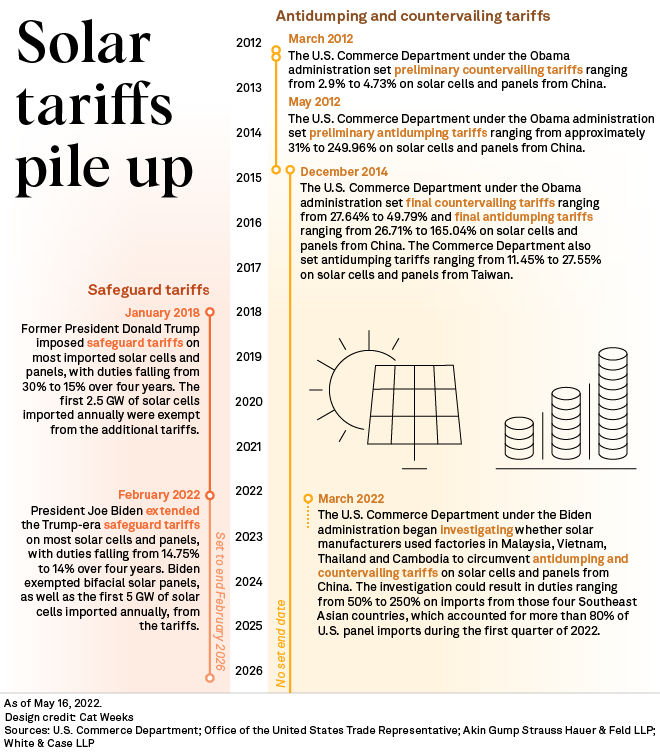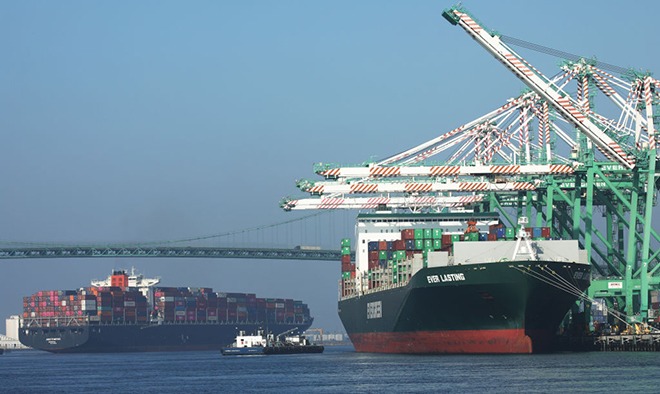This summer, Convalt Energy Inc. expects to break ground on a solar panel factory in upstate New York costing more than $500 million.
Once construction is underway, the company will start gathering permits to expand into manufacturing silicon ingots, wafers and cells — the building blocks of solar panels whose production is now largely controlled by China, Convalt Chairman, President and CEO Hari Achuthan said.
The plan is just the sort of endeavor the U.S. Department of Energy has called for to jumpstart an American solar supply chain and begin freeing the industry from Beijing.
An integrated factory complex like the one Achuthan has in mind could spark demand for American polysilicon, a key raw material in most solar panels, and ease broader dependence on supply chains linked to China, the DOE said in a February report.
If built, it would be a rare win for U.S. solar manufacturing. America relies almost entirely on factories in Asia for the components it needs to turn sunlight into electricity. As of February, most U.S. polysilicon factories had been idled or repurposed to supply the semiconductor industry, according to the DOE. The country had no active ingot, wafer or cell capacity, and little panel assembly.
China, meanwhile, accounts for between 70% and 98% of the world’s production capacity of the silicon-based raw material and components in solar panels.
The dominance of solar companies closely tied to China poses "significant risk" to the U.S. market, according to the DOE, due to Beijing's "documented human rights violations and ... unpredictable trade relationship with the United States." Russia's invasion of Ukraine has further amplified concerns about energy security and China's dominance of critical supply chains.
Beijing has denied committing human rights abuses. The Chinese Embassy in Washington did not respond to a message seeking comment.
Despite bipartisan concerns, Washington has been unwilling to provide targeted incentives for projects like Convalt's. Instead, the U.S. government has subsidized project development while imposing tariffs on imports that over the past decade have failed to grow a base of domestic solar manufacturing.
Magnifying this tension, a new investigation by the U.S. Commerce Department into whether solar manufacturers circumvented tariffs on Chinese shipments by moving some operations to Vietnam, Malaysia, Thailand and Cambodia threatens expected solar installations in 2022 and 2023. The probe follows President Joe Biden's decision in February to extend Trump-era solar tariffs.
"There seems to be no clear resolution of how to rapidly adopt and implement and deploy renewable energy domestically without relying on Chinese supply chains," said Ilaria Mazzocco, a fellow with the Trustee Chair in Chinese Business and Economics at the Center for Strategic and International Studies, a think tank in Washington, D.C.
 |
After Congress failed last year to pass a bill packed with renewable energy spending, including incentives for solar manufacturing, lawmakers have started discussing new legislation focused on climate and energy security. The outlook and timing for such a bill are unclear. Policy disagreements among Democrats derailed the party's last effort to advance major pieces of Biden's agenda.
The DOE has said the U.S. should provide at least 10 years of tax credits for solar manufacturing, since factories can take several years to build, with the richest subsidies reserved for making silicon ingots and wafers.
"If you're going to maintain a reliable trajectory towards decarbonization over time, you probably shouldn't have all of your product coming out of your main geostrategic competitor," said Joseph Osha, a managing director and senior research analyst at Guggenheim Securities. "This isn't something that's outside the grasp of policy, but it would require a level of [political] determination that, so far, we haven't seen."
Depending on available incentives, the U.S. could triple its panel-making capacity to 22 GW — close to total U.S. demand in 2021 — as well as create up to 8 GW of cell capacity and up to 6 GW of wafer and ingot capacity, according to an analysis of project announcements in 2021 by the National Renewable Energy Laboratory.
Without long-term federal aid, many doubt the U.S. will ever have a solar supply chain beyond piecing together panels from imported parts, the easiest and cheapest step in the process.
"There is a lot of talk about building out the solar supply chain," said Xiaojing Sun, global head of solar at Wood Mackenzie, an energy research and consulting firm. However, "nobody has really broken ground yet, and I think there is a reason for that."
South Korea's Hanwha Solutions Corp. has said it is ready to invest billions of dollars to help build a U.S. solar supply chain, from polysilicon to panels, provided Washington creates new incentives. Maxeon Solar Technologies Ltd., which is headquartered in Singapore, has also said it wants to open a U.S. panel factory, contingent on government support. If Maxeon moves forward with its plan, it could offset the loss of a solar panel factory in Alabama owned by South Korea's LG Electronics Inc., which in February said it was exiting the solar business under pressure from high raw material and logistics costs.
Meanwhile, Chinese solar manufacturers continue adding capacity, cementing their advantages of scale. By the end of the year, China's JinkoSolar Holding Co. Ltd. expects to have 60 GW of annual panel-making capacity, equivalent to around one-quarter of projected global demand.
"I really struggle to see in the absence of [federal aid] how you get that scale, the globally competitive type of industry that we all really need," said Scott Moskowitz, director of strategy and market intelligence at Hanwha subsidiary Q CELLS North America, which operates a solar panel factory in Georgia.
Despite the uncertainty in Washington, Convalt is pressing ahead.
Equity financing for Convalt's panel factory is coming from current shareholders, and the company is working with a lender that specializes in rural economic development to seek a loan guarantee from the U.S. Department of Agriculture, said Achuthan, who also leads ACO Investment Group, an infrastructure investor. Convalt has already secured some local incentives.
Phase two of the project — the ingot-wafer-cell factory — is a more expensive undertaking that looks harder to pull off without federal aid. "We're waiting for the federal government to see if they can push [manufacturing incentives] through Congress, which will only help," Achuthan said. Regardless of what happens in Congress, however, Convalt expects to have a factory up and running by mid-2024.
"We're going to find that patriotic [investor] to get it done," Achuthan said.

Constant battle
The U.S. solar industry has been embroiled in trade fights for more than a decade as successive administrations levied tariffs on low-cost imports, which helped fuel demand but drove U.S. producers out of business.
After filing for bankruptcy in 2017, Suniva Inc., one of America's last remaining solar cell manufacturers, pressed the Trump administration to impose new tariffs on imported cells and panels. Without more trade restrictions, the U.S. risked losing out permanently to China "and its proxies in southeast Asia and other global outposts," a Suniva executive told the U.S. International Trade Commission at the time.
Soon after, REC Silicon ASA closed a polysilicon plant in Washington state. The company said it was a victim of Chinese tariffs that cut off American producers from nearly all of their potential customers, China's silicon ingot and wafer manufacturers.
Efforts by the Trump administration to open China's solar market to U.S. polysilicon failed, while the tariffs it layered on top of those set by the Obama administration only boosted panel manufacturing, which does little to improve economic or energy security.
Even with the added panel capacity, America's solar market remains heavily dependent on factories in Asia. For the past three years, the country has imported enough solar panels to meet at least 93% of annual domestic demand, according to data from the U.S. Energy Information Administration.
Biden entered office in 2021 promising to change that dynamic, saying he would accelerate renewable energy deployment while boosting U.S. manufacturing. Since then, however, the administration has taken actions on trade policy that have angered project developers, potentially cutting off supplies of foreign-made panels without delivering a domestic manufacturing strategy.
A White House spokesperson did not respond to a message seeking comment.

The Solar Energy Industries Association, a lobbying group, acknowledges the U.S. is too reliant on imports but has argued tariffs are counterproductive.
The DOE, which has expressed concern that the Commerce Department probe is hurting the U.S. market, in February said Washington should create tax credits for solar manufacturing to capitalize on the "economic opportunity inherent in the energy sector transition." The Congressional-Executive Commission on China, a panel of U.S. lawmakers and administration officials that monitors human rights in that country, has also advocated for incentives to create a U.S. supply chain to "eliminate reliance on products made with forced labor."
U.S. Customs and Border Protection issued a trade restriction in 2021 against a top raw material supplier to the solar industry that allegedly abused workers in China's Xinjiang region, where the U.S. has accused Beijing of persecuting Uyghurs and other Muslim minorities. Months later, Biden signed the Uyghur Forced Labor Prevention Act, which beginning in June will ban shipments linked to Xinjiang unless importers can prove goods were not made with forced labor.
Responding to the U.S. crackdown, some Chinese manufacturers have said they are creating supply chains outside of Xinjiang to serve the American market. However, those expansions have been met with skepticism.
"None of the investors we work with are happy to settle for a bifurcated supply chain," said Anita Dorett, program director for the Investor Alliance for Human Rights, which represents institutional investors with more than $10 trillion in AUM, in an interview. "The issue really is that we need to reimagine our solar industry."

Many in the U.S. solar industry have expressed frustration with President Joe Biden, whose administration has bogged down the country's solar market with a federal trade investigation. |
'Two most important things’
Among U.S. solar project developers, however, overhauling supply chains and onshoring manufacturing does not appear to be a top priority.
"I think most folks in the U.S. are comfortable importing these solar panels from where they are manufactured globally as efficiently as possible," said Jesse Grossman, CEO of Soltage LLC, a solar project developer.
"What we're actually concerned about is jobs that come from installing and maintaining these assets, the investment that we're able to put into domestic projects that are going up all across the country at increasing velocity and, more importantly, the clean [energy] we get out of those panels," Grossman said.
On an earnings call April 21, John Ketchum, president and CEO of NextEra Energy Inc., one of the world's largest renewable energy companies, criticized the Commerce Department for disrupting the solar industry with the trade investigation after he said manufacturers had already begun moving supply chains away from China.
"From our standpoint, a consumer of solar panels, whether they be domestic or imported into the country, what's important to us is that we have price competitiveness and we have availability. Those are the two most important things," David Reuter, a vice president at NextEra and the company's chief communications and marketing officer, said in an interview.
"We absolutely support a larger domestic solar panel mix and manufacturing," Reuter said, "but that doesn't mean that we're going to sit on our hands for three years and wait for that to happen."
Critics say, however, that prioritizing the needs of project developers has hindered efforts to create a U.S. supply chain.
"The fact of the matter is, I think that our chase for efficiency over the past several decades has really compromised our security and our sense of security," U.S. Trade Representative Katherine Tai told the House Ways and Means Committee in March.
"In industries that we have lost, and we see this also in solar, it is so difficult to rebuild," Tai said. "We end up fighting each other through stakeholders regionally here in the U.S., and we end up fighting our allies over the scraps that are left to us in the global marketplace."

The U.S. solar market depends on cargo ships like these at the Port of Los Angeles to deliver equipment from factories in Asia. |
'Bring it all back'
Despite the long odds, a group of companies continues to see big opportunities in onshoring solar supply chains, either in the U.S. or in North America more broadly.
It remains to be seen whether investors share their vision.
In Massachusetts, Leading Edge Equipment Technologies Inc. is preparing to raise money this summer for a pilot project for silicon wafer manufacturing. If all goes to plan, the company will have more than 30 GW of U.S. production capacity within several years, CEO Rick Schwerdtfeger said.
"We are, I think, in a unique position because of our cost advantage. Investors are still going to be attracted to us regardless of incentives that pass in Washington," Schwerdtfeger said, adding, "I know a lot of investors and a lot of companies waiting for those incentives to pass, because other aspects of the supply chain are going to be more dependent on those incentives than we are."
Canadian Premium Sand Inc., which is trying to become the first North American manufacturer of glass used in solar panels, also will be cost competitive with manufacturers in Asia, according to Glenn Leroux, the company's president and CEO. However, Leroux said he still must win over investors, many of whom prefer "quick flip" deals to long-term bets on manufacturing.
With manufacturing incentives stalled in Congress, Convalt's Achuthan said he welcomes the prospect of more solar tariffs from the Commerce Department, hopeful that the old policies will prove more effective than they have in the past.
"We as a nation have got to go through the short-term pain, do a reset, bring it all back to America," Achuthan said. "Now the banks would say, 'OK, the policies are there, I see how difficult it is to import. I'll support American manufacturing.'"
S&P Global Commodity Insights produces content for distribution on S&P Capital IQ Pro.



